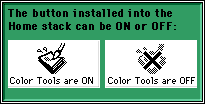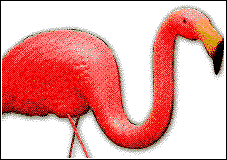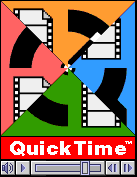| Index | Buttons | Fields | Message | Variables |
| Ask/Answer | Colour | Sound | Menus | QuickTime |
HyperCard 2.3 (review by Mark Gregory)

Every Mac since the latter half of 1987 has included some version of Bill Atkinson's HyperCard in its bundled software. In the early days you got the whole program, by the time the program had reached version 2.1 you got a Player version. In those eight years more than a dozen books have been published to guide HyperCard users on the path to becoming HyperCard programmers. One of the books claims "Over 400,000 Copies in Print". HyperCard programs or Stacks are available in the thousands from various storehouses on the Internet. There are CD-ROMs full of such stacks from a number of Macintosh User Groups. When it was first released Apple came up with the slogan "Programming for the rest of us".

Maybe because of its widespread use and becouse of an extraordinary variety of uses, HyperCard has proved notoriously difficult to define. After pages of description Danny Goodman in "The Complete HyperCard 2.2 Handbook" came up with the following summary.
"The key to HyperCard's success has been that it empowers people with expertise who might otherwise not have been able to express themselves on the Macintosh. Whether that expertise be in mainframe electronic mail, a department's personnel policies, the Cyrillic alphabet, or a compact disc library organisation, HyperCard lets you put that expertise on the Mac - to offer tools to others in the same field, to share information, and to be more productive every day".

HyperCard version 2.3 has just been released so what does it offer that's not in earlier models?
In my view it's not so different from 2.2. That version (created when Apple took the program back from Claris) provided two major improvements, colour and the possibility of building standalone stacks. It's true that in 2.3 there are now tools which mean that you can draw and paint in colour in HyperCard, but in real life those operations are far better accomplished in specialised drawing and painting programs. 2.2 and 2.3 both support AppleScript which I'm afraid still remains a complete mystery to me although I've seen it used a lot for making CGI's (Common Gateway Interface) on the World Wide Web.
With 2.2 came popup buttons and oval buttons and fields that behave like lists. In practice popup buttons were commonly available as XCMD's for earlier versions and simple scripting could make a scrolling field act as a list for such purposes as indexes, while XCMD's such as ListSelect made list fields old hat. Other improvements in 2.2 included being able to use buttons as containers (just as locked fields could always be used as buttons I suppose), being able to disable buttons so they are dimmed or greyed and having "families" for radio buttons so if one is on the others turn off.

After eight years and half a dozen versions HyperCard is holding up well. It has not been superseded by SuperCard as the official retailers of that program like to claim. It is still the most versatile of programs for the development of multimedia. Commercial products such as Myst and Lake Iluka attest to its great potential, while educationalists, ever strapped for cash, can justify its modest price ($195.00). It would be wonderful to see a Windows version of course, or even a Windows player, and you do occasionally read hints that lead you think it might happen.

Meanwhile although it's still a best seller, and more useful books have been written about using it than all the other "multimedia" programs put together, HyperCard seems to have escaped (or been denied) the hype and marketing that its competitors trumpet so loud. You sometimes get the impression that Apple would love to drop HyperCard but the loyalty of its users wont let it be killed off. Or maybe it's just one of those underground or alternative phenomena.

If you are still using an earlier version, upgrade, if you've only got the Player buy a full copy. You get well written manuals and plenty of ready to use stacks. (You even get AddMotion thrown in, though I've never met anyone who uses it!). HyperCard is still "programming for the rest of us", a program that thousands of men and women have learned to use to make tens of thousands of stacks.
Hypercard turned eight on 11th August 1995.